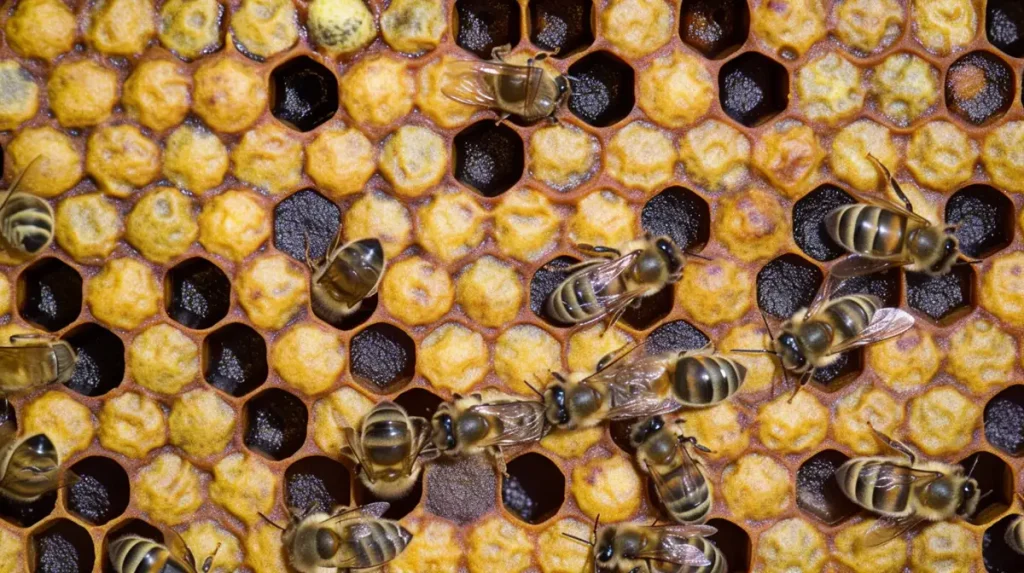Table of Contents
As a beekeeper, you need to be aware of the most common bee diseases that can affect your honeybees. In this article, I offer a brief overview of these diseases , including their symptoms, life cycle, and treatment options.
A detailed table of diseases that affect bees:
| Disease Name | Causative Agent | Affected Bee Stage | Symptoms | Treatment/Management Strategies |
|---|---|---|---|---|
| American Foulbrood (AFB) | Paenibacillus larvae | Larvae | Sunken, dark-colored brood caps, sticky and ropey larval remains, foul odor | Burn infected colonies/materials; antibiotics (e.g., tylosin) as a preventive measure; resistant strains require more stringent measures |
| European Foulbrood (EFB) | Melissococcus plutonius | Larvae | Irregular brood pattern, yellow-white larval remains that don’t rope, no foul odor | Antibiotics (e.g., oxytetracycline) in some regions; improve colony strength and hygiene; replace queen |
| Chalkbrood | Ascosphaera apis | Larvae | Hard, chalk-like mummies of larvae in and around the hive; varies in color from white to black | Increase hive ventilation; ensure strong colony; requeen if persistent |
| Sacbrood | Sacbrood virus (SBV) | Larvae | Fluid-filled sac containing the larva, which fails to pupate; sunken cappings | Remove and destroy affected brood; enhance colony strength; no specific treatment |
| Nosemosis | Nosema apis and Nosema ceranae | Adult bees | Dysentery, reduced lifespan, crawling bees at hive entrance, poor winter survival | Fumagillin treatment (where legal); good apiary hygiene; strengthen colony before winter |
| Stonebrood | Various fungi in the Aspergillus genus | Larvae and pupae | Hard, stone-like fungal growths inside infected bees | No specific treatment; maintain strong colonies and good hive conditions to reduce susceptibility |
| Black Queen Cell Virus (BQCV) | Black queen cell virus | Queen larvae and pupae | Queen cells turn black and larvae die; often associated with Nosema infection | No direct treatment; control Nosema and maintain colony health to mitigate impacts |
| Chronic Bee Paralysis Virus (CBPV) | Chronic bee paralysis virus | Adult bees | Trembling, inability to fly, shiny and hairless appearance, death around the hive | Remove affected individuals; requeen to improve colony vitality; minimize stress on bees |
| Deformed Wing Virus (DWV) | Deformed wing virus | Adult bees (emerging) | Deformed or absent wings, shortened abdomen, reduced lifespan, increased susceptibility to other diseases | Control varroa mite populations as primary vectors; maintain colony strength and hygiene |
This table highlights the complexity of bee health management and the importance of integrated disease control measures, including maintaining strong colonies, practicing good apiary hygiene, and monitoring for early signs of disease to implement appropriate treatments.
American Foulbrood
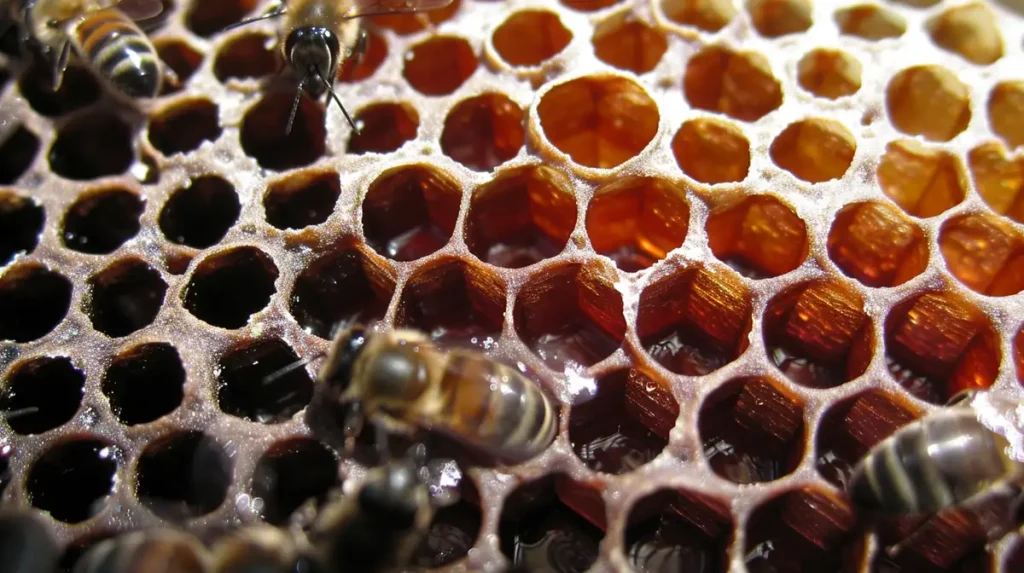
American foulbrood is a bacterial disease that affects honeybee larvae. It is caused by the bacterium Paenibacillus larvae and is highly contagious. The disease is spread when infected larvae die and release spores, which can then infect healthy larvae.
Symptoms of American foulbrood include sunken cappings, foul odor, and discolored larvae. The larvae become brown and gooey, and the affected cells may have a dark or sunken appearance. The disease can be fatal to the colony if left untreated as the infected cells can spread the disease to healthy cells.
To prevent and treat American foulbrood, there are a range of options available. These include:
- Antibiotics: The use of antibiotics, such as oxytetracycline or terramycin, can be effective at treating American foulbrood. However, these antibiotics must be used carefully and according to the instructions, as they can also harm the bees and contaminate the honey.
- Destruction of the Infected Hive: In some cases, the best course of action is to destroy the infected hive. This involves burning the hive and all of its contents to prevent the spread of the disease to other hives.
- Preventative Measures: Beekeepers can take preventative measures to avoid the spread of American foulbrood. This includes regular inspections of the hive, maintaining good hygiene and cleanliness, and using new or sterilized equipment. If an infected hive is identified, it should be isolated and treated immediately to prevent the spread of the disease to other hives.
It’s important to note that prevention is the best way to avoid American foulbrood. Beekeepers should ensure that their hives are kept clean and free from debris and that the bees are healthy and strong. Regular inspections of the hive are crucial to detecting American foulbrood early, so that treatment can be initiated before the disease becomes too severe.
American foulbrood is a serious disease that can be fatal to honeybee colonies. Beekeepers can take a range of preventative measures to avoid the spread of the disease and use appropriate treatments when necessary. Regular inspections of the hive are crucial to detecting American foulbrood early, so that treatment can be initiated before the disease becomes too severe.
European Foulbrood
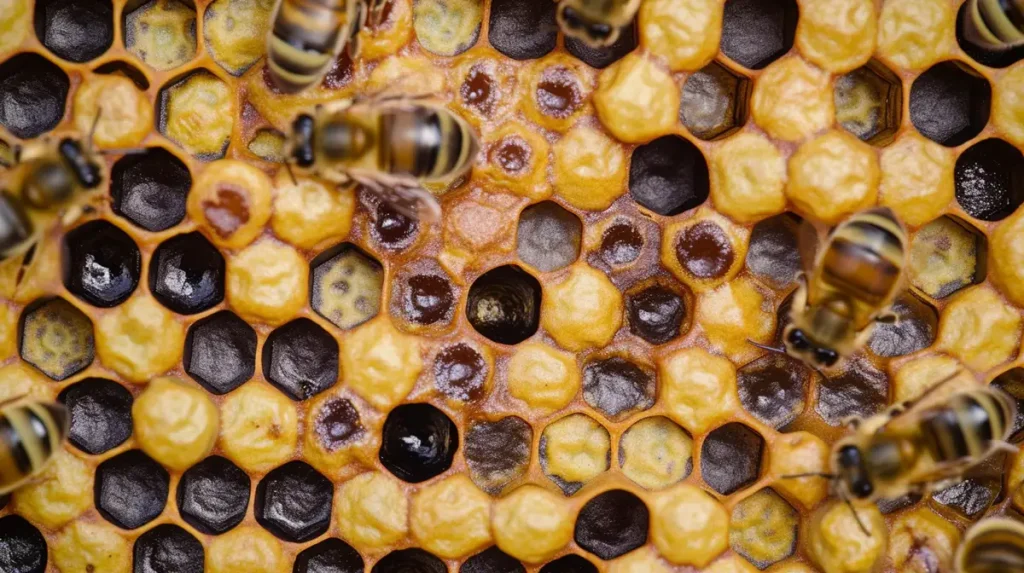
European foulbrood is another bacterial disease that affects honeybee larvae. It is caused by the bacterium Melissococcus plutonius and is highly contagious. The disease is spread when infected larvae die and release spores, which can infect healthy larvae.
Symptoms of European foulbrood are not too dissimilar to American foulbrood and include discolored larvae, foul odor, and sunken cappings. The larvae become yellowish-brown and dry and the affected cells may have a sunken or perforated appearance. The disease can be fatal to the entire colony if not treated as infected cells spread the disease to nearby healthy cells.
For prevention and treatment of European foulbrood, there are a range of options available to beekeepers:
- Antibiotics: Although antibiotics such as oxytetracycline or tylosin can effectively treat European foulbrood, they need to be used with caution and in accordance with the instructions because of the potential to harm bees and contaminate honey within the hive.
- Destruction of the Infected Hive: Sometimes the most effective way to contain the spread of the disease to other hives is to destroy the infected hive completely by burning both the hive and its contents.
- Preventative Measures: Beekeepers can take preventative measures to avoid the spread of European foulbrood. These are similar to the preventative measures described above regarding American foulbrood.
Prevention is the best way to avoid European foulbrood. Make sure hives are kept clean and that the bees are healthy. Regularly inspect the hive as early detection of European foulbrood is crucial.
Nosema
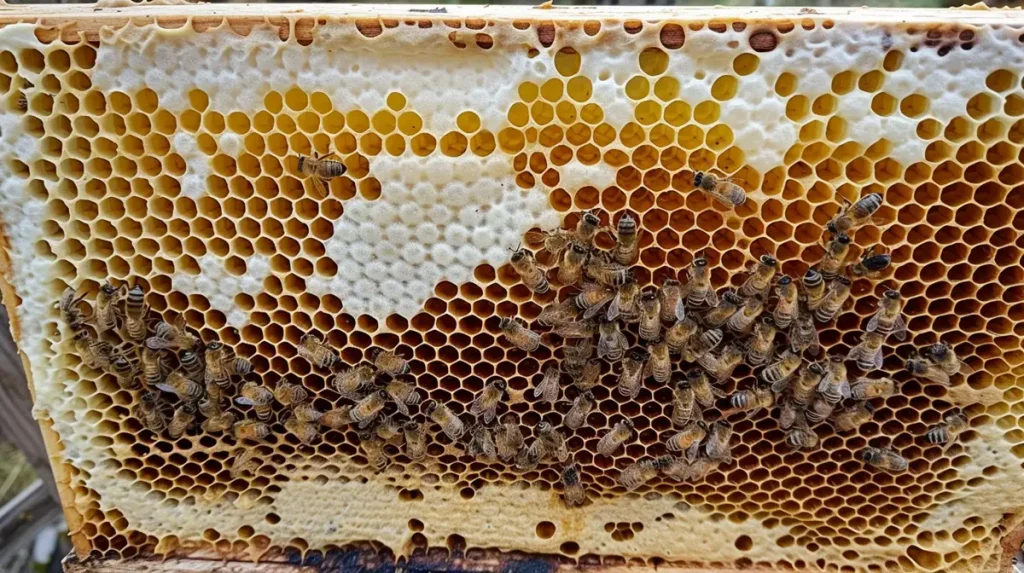
Nosema is a fungal disease that affects the gut of the honeybee. It is caused by the microsporidian fungi Nosema apis and Nosema ceranae. The spores of the fungus are ingested by the bees, and they grow and multiply in the gut, causing damage to the intestinal lining. This can reduce the lifespan of the bees and weaken the colony.
- Carter, Anthony (Author)
- English (Publication Language)
- 194 Pages - 02/28/2024 (Publication Date) - Independently published (Publisher)
Symptoms of Nosema include dysentery, reduced population, and reduced honey production. Bees infected with Nosema may defecate inside the hive, resulting in a build-up of feces and an unpleasant smell. The disease can also cause the bees to have a reduced appetite, which can result in a weaker colony.
To prevent and treat Nosema, beekeepers have a range of options available. These methods include:
- Antibiotics: The use of antibiotics, such as fumagillin, can be effective at treating Nosema. Fumagillin is a prescription drug and should be used under the guidance of a veterinarian.
- Natural Treatments: Natural treatments such as probiotics or essential oils can also be effective at treating Nosema. Probiotics can help to restore the gut microbiome and improve the bees’ digestion, while essential oils can help to boost the bees’ immune system and reduce the fungal load.
- Hygiene and Nutrition: Good hygiene and nutrition are also important in preventing Nosema. Beekeepers should ensure that the hives are kept clean and free from debris, and that the bees have access to a healthy diet. This includes providing them with pollen and nectar sources and supplementing their diet with sugar syrup when necessary.
As in the case with the American and European foulbrood diseases mentioned above, prevention is the best way to avoid Nosema. Ensure hives are kept clean and free from debris and that the bees are healthy. Inspect the hive regularly.
Nosema is a serious fungal disease that can weaken the honeybee colony. Beekeepers can take a range of preventative measures to avoid the spread of the disease and use appropriate treatments when necessary. Regular inspections of the hive are crucial to detecting Nosema early so that treatment can be initiated before the disease spreads are becomes severe. Good hygiene and nutrition are also important in preventing Nosema.
Chalkbrood
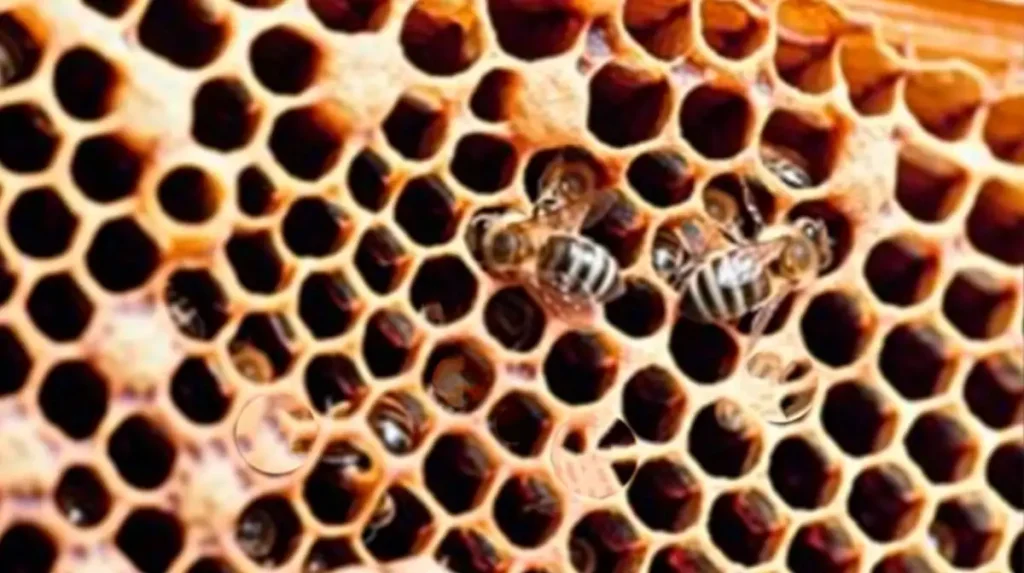
Chalkbrood is a fungal infection that affects honeybee larvae, caused by the fungus Ascosphaera apis. It thrives in cool, damp conditions and infects the larvae after they ingest the spores. The disease is characterized by the presence of mummified larvae that appear chalk-like, varying in color from white to black, depending on the age of the mummification.
Symptoms include mummified larvae within the cells, which can be easily spotted during hive inspections. The mummies are hard and may be found at the hive entrance or on the bottom board, as worker bees attempt to remove the infected larvae from the hive.
To manage and prevent Chalkbrood, beekeepers should focus on:
- Ventilation Improvement: Ensure the hive has good airflow to reduce humidity, which is conducive to the spread of the fungus.
- Colony Strength: Maintain strong colonies through good nutrition and management practices, as stronger colonies are less susceptible to infection.
- Hive Management: Regularly inspect hives for signs of the disease and remove any mummified larvae to reduce spore load.
- Requeening: Consider requeening with queens from stock that shows resistance to Chalkbrood.
Preventative measures include maintaining strong, healthy colonies and ensuring that hives are well-ventilated to avoid the damp conditions that facilitate the spread of the fungus.
Sacbrood
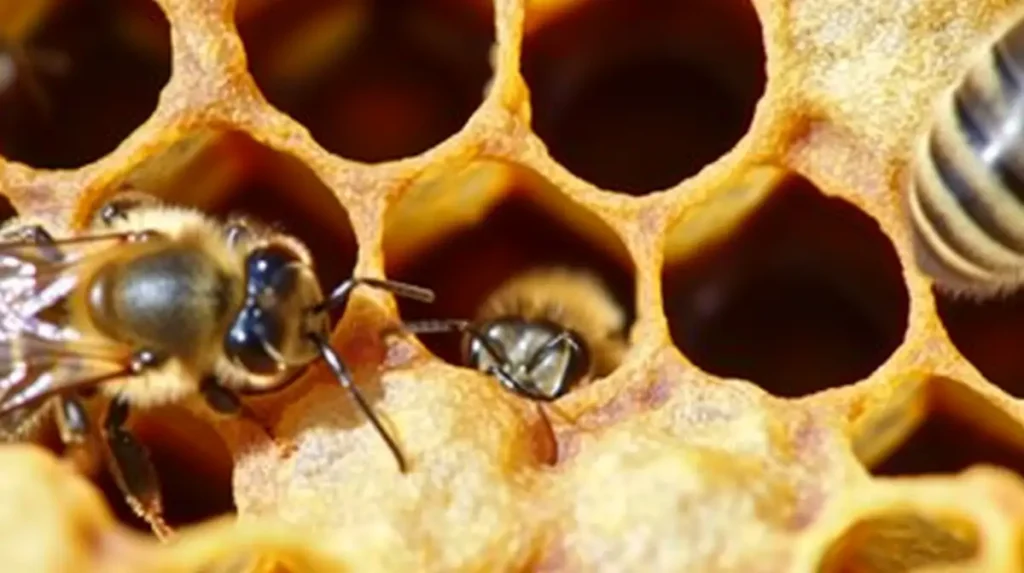
Sacbrood is a viral disease caused by the Sacbrood virus (SBV), affecting honeybee larvae. The disease manifests as a failure of the larva to pupate, leading to the formation of a fluid-filled sac. Infected larvae are typically seen with their heads raised upwards, and the sac can cause the skin to appear shiny and translucent.
Symptoms also include the presence of larval remains that are easily removed from the cell, looking like a water-filled sac. The disease is usually not fatal to the colony but can weaken it by reducing the population of emerging bees.
Management and prevention strategies for Sacbrood include:
- Removal of Infected Brood: Carefully removing and destroying infected brood can help prevent the spread within the hive.
- Enhancing Colony Strength: Providing good nutrition and ensuring the colony is strong can help minimize the impact of the disease.
- Regular Monitoring: Keeping an eye on the brood pattern and health can help in early detection and management of the disease.
There is no specific treatment for Sacbrood, so maintaining healthy, robust colonies is the best defense against the disease.
Stonebrood
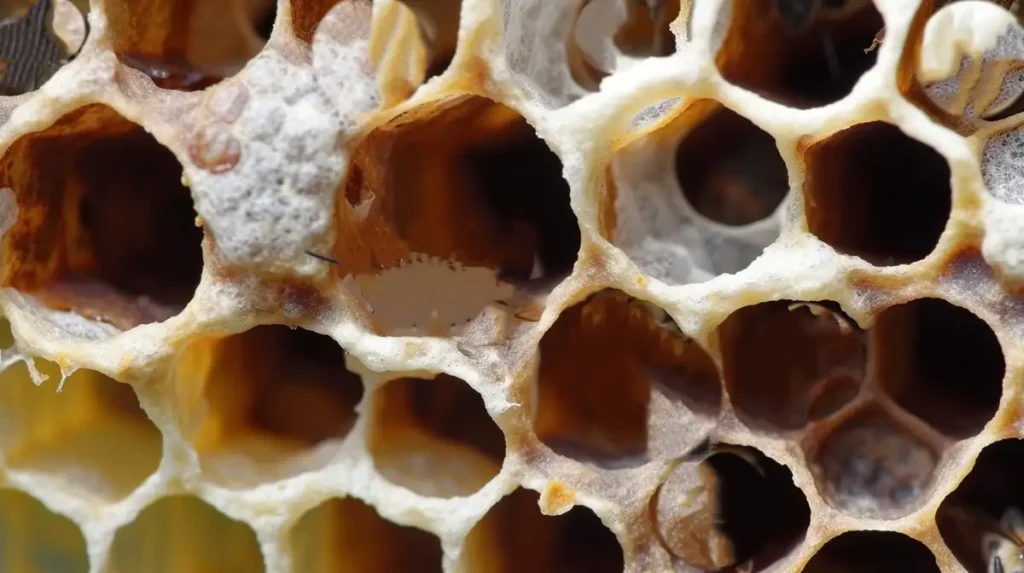
Stonebrood is a fungal disease caused by various species of the Aspergillus fungus, affecting both larvae and adult bees. The disease results in the formation of hard, stone-like fungal growths inside infected individuals, leading to death.
Symptoms are not always visible outside the infected bees, but affected larvae and adults can sometimes be spotted with fungal growths when dissected. Stonebrood can weaken colonies through the loss of larvae and adults but is typically not as devastating as some bacterial brood diseases.
Management of Stonebrood involves:
- Environmental Control: Since Aspergillus thrives in damp conditions, reducing hive moisture through good ventilation is crucial.
- Colony Health: Keeping colonies strong and well-fed can help reduce susceptibility to infection.
- Hygiene Practices: Regular cleaning of equipment and avoiding the use of old or moldy combs can prevent the spread of spores.
Preventative measures focus on maintaining a dry, healthy hive environment to discourage fungal growth.
Black Queen Cell Virus (BQCV)
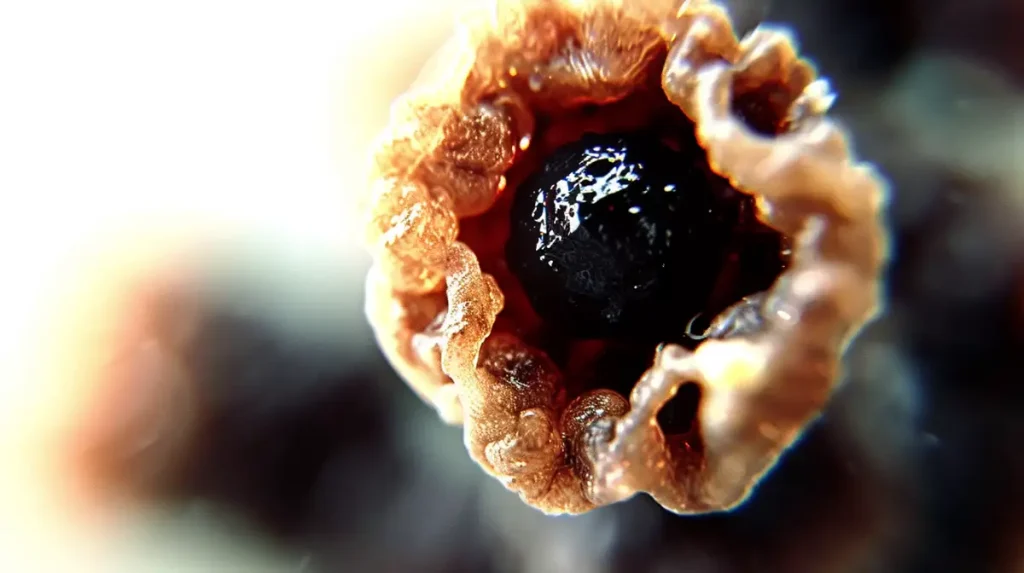
Black Queen Cell Virus primarily affects queen larvae and pupae, leading to their death within the queen cells, which turn black as a result. This virus is often found in conjunction with Nosema infections.
Symptoms include the darkening of queen cells and the death of queen larvae before pupation. BQCV can impact queen rearing significantly if not managed.
Management strategies for BQCV are largely preventive:
- Nosema Control: Controlling Nosema can help reduce the incidence of BQCV, as there is a correlation between the two diseases.
- Hygienic Practices: Maintaining clean, healthy colonies and practicing good apiary hygiene can help prevent the spread of the virus.
- Regular Monitoring: Inspect queen cells during rearing to identify and remove infected cells promptly.
There is no direct treatment for BQCV, so prevention and maintaining overall colony health are key.
Chronic Bee Paralysis Virus (CBPV)
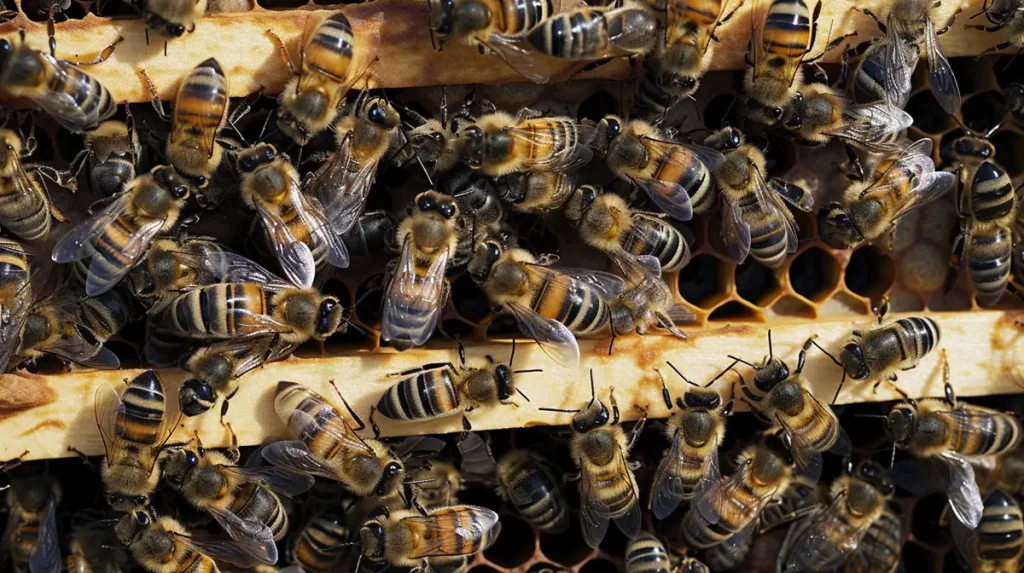
Chronic Bee Paralysis Virus causes a condition in adult bees characterized by trembling, inability to fly, hairless bodies, and eventual death outside the hive. The disease can lead to significant losses if it spreads through the colony.
Symptoms include bees congregating at the hive entrance, displaying abnormal behavior such as trembling and paralysis. Infected bees may appear shiny and black due to the loss of hairs.
Management and prevention of CBPV focus on:
- Removal of Affected Bees: Removing symptomatic bees can help reduce the spread within the colony.
- Colony Stress Reduction: Minimizing stress through proper nutrition, gentle handling, and avoiding overcrowding can help improve colony resilience.
- Regular Monitoring: Keeping an eye on adult bee behavior can assist in early detection of the disease.
There are no specific treatments for CBPV, making prevention through good colony management essential.
Deformed Wing Virus (DWV)
Deformed Wing Virus is a serious viral disease transmitted by Varroa mites, leading to deformed wings, shortened abdomens, and a reduced lifespan in honey bees. The presence of Varroa mites in a colony significantly increases the spread and impact of DWV.
Symptoms include emerging adult bees with deformed or absent wings, leading to an inability to fly and perform normal bee activities, severely impacting the colony’s foraging capacity and overall health.
Management and prevention include:
- Varroa Mite Control: Effective control of Varroa mite populations is crucial in managing DWV, as mites are the primary vectors of the virus.
- Colony Strength: Maintaining strong, healthy colonies can help mitigate the impact of the disease.
- Hygienic Practices: Implementing hygienic practices such as regular brood comb replacement and hive inspections can help identify and manage infestations early.
Controlling Varroa mites is the most effective strategy against DWV, highlighting the importance of integrated pest and disease management in beekeeping.
Bee Diseases – Conclusion
In conclusion, as a fellow beekeeper, it’s crucial to be aware of common diseases that can affect honey bees. By using a combination of preventive and treatment methods, you can help keep your hives healthy and productive. Regular monitoring and good hive hygiene are key to preventing and controlling diseases, and it’s important to act quickly if any signs of disease are detected. Remember, healthy bees mean healthy hives, and healthy hives mean delicious honey and a thriving ecosystem.
Looking to up your beekeeping game? Check out our latest product recommendations so you can take things to the next level!
Introducing The Top 12 Best Beekeeping Veils For 2024
Introducing The Top 20 Best Beekeeping Gloves For 2024
Introducing The Absolute Best Beekeeping Suits For 2024
The 15 Top Beekeeping Books for 2024
The Top 11 Honey Extractors for 2024
The Top 12 Mason Bee Houses for 2024
Beekeeping Disclaimer:
Beekeeping, like any agricultural activity, involves inherent risks. It is important to understand these risks and take appropriate measures to mitigate them.
Potential risks associated with beekeeping include:
- Bee stings: Honey bees are generally not aggressive but can become defensive if they feel threatened or their hive is disturbed. Bee stings can cause allergic reactions or even anaphylaxis in some individuals, which can be life-threatening. It is important to wear protective clothing and follow best practices when handling bees to minimize the risk of stings.
- Diseases and pests: Bees can be vulnerable to various diseases and pests, including mites, viruses, and bacterial infections. These can have significant impacts on bee colonies, leading to reduced honey production or even colony collapse. It is important to monitor hives regularly and take appropriate measures to prevent and treat diseases and pests.
- Weather conditions: Extreme weather conditions, such as drought or cold temperatures, can affect the health and productivity of bee colonies. It is important to ensure that hives are appropriately sheltered and provided with adequate food and water.
- Environmental hazards: Bees can be affected by environmental hazards such as pesticide exposure, pollution, and habitat loss. It is important to be aware of these hazards and take appropriate measures to protect bee colonies and promote healthy environments for bees.
- Legal requirements: Beekeeping may be subject to local, state, or national regulations, such as registration or inspection requirements. It is important to be aware of these requirements and comply with them.
While beekeeping can be a rewarding and enjoyable activity, it is important to be aware of the potential risks and take appropriate measures to mitigate them. By following best practices and staying informed about the latest developments in beekeeping, beekeepers can help ensure the health and productivity of their hives and contribute to the well-being of bee populations worldwide.
Medical Disclaimer: The content provided in this blog post is for informational purposes only and is not intended as medical advice, or to replace the advice of a healthcare professional. Bee stings can cause allergic reactions in some individuals, which can be severe and require immediate medical attention. Similarly, consuming bee products, including honey, pollen, propolis, and royal jelly, can cause adverse reactions in people with specific allergies or intolerances. If you experience any negative reactions or are unsure about your allergies, consult with a healthcare provider promptly. The views expressed in this article are based on current knowledge and do not cover all possible health implications. Always seek the advice of your physician or another qualified health provider with any questions you may have regarding a medical condition or before starting any new treatment.
Last update on 2024-04-17 / Affiliate links / Images from Amazon Product Advertising API

